(PubMed)—A 39-yo woman w/ invasive breast carcinoma was being followed by a personalized medicine clinic where CYP2D6 genotyping and therapeutic monitoring of tamoxifen and active metabolite endoxifen were being carried out. Following admission for a flare of ulcerative colitis and testing positive for latent TB, she was started on rifampin x4mo in preparation for anti-TNFα tx. However, the pt could only tolerate rifampin for 10 days before it was discontinued. Other meds included ascorbic acid, vitamin D, dalteparin, ferrous gluconate, and methylprednisolone. The endoxifen level measured 2wk after rifampin d/c was subtherapeutic, while the tamoxifen level was 24% lower than baseline. The pt, known to be a CYP2D6 intermediate metabolizer, had therapeutic endoxifen levels prior to this admission.
Which drug interaction can cause a decrease in tamoxifen and endoxifen levels?
Which drug interaction can cause a decrease in tamoxifen and endoxifen levels?

|
vitamin D
|
|
rifampin
|
|
methylprednisolone
|
|
dalteparin
|
All of these are common eye symptoms linked to COVID-19 EXCEPT for:

|
dry eye or foreign body sensation
|
|
eye pain
|
|
discharge
|
|
redness
|
|
photophobia
|
|
tearing
|
|
itching
|
Can you identify this pill?

|
dexmethylphenidate
|
|
Actos (pioglitazone)
|
|
nitroglycerin
|
|
Zubsolv (buprenorphine/naloxone)
|
